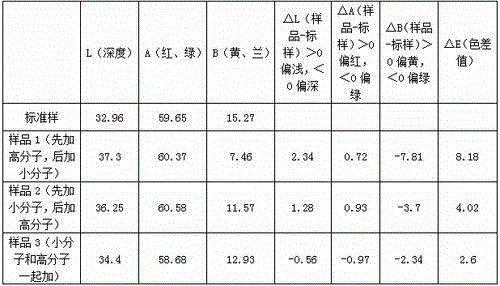Modified cellulose fibers obtained through modification
A cellulose fiber modification technology, applied in the field of modified cellulose fiber and cellulose fiber, can solve the problems of high chroma of dyeing raffinate, large amount of alkali consumption, difficult treatment of waste water, etc., to avoid dye flocculation and uniform dyeing , Modified uniform effect
- Summary
- Abstract
- Description
- Claims
- Application Information
AI Technical Summary
Problems solved by technology
Method used
Image
Examples
Embodiment 1
[0060] Modified cellulose fibers:
[0061] The modified cellulose fiber obtained through modification, the modified cellulose fiber is made of cellulose fiber through a small molecular quaternary ammonium salt cationic modifier and a high molecular weight quaternary ammonium salt cationic modifier as a cationic modifier, Carry out modification treatment, when the obtained pH value is 6.5-8.5, the Zeta electrode potential value is the modified cellulose fiber of 0-25mV; Described small molecule quaternary ammonium salt cationic modifier is epoxy quaternary ammonium salt compound, The high molecular weight quaternary ammonium salt cationic modifier is a cationic polyacrylamide compound.
[0062] The above is the modified cellulose fiber of the present invention. Due to the small molecular weight of the small molecular quaternary ammonium salt cationic modifier, it can not only be adsorbed on the surface of the fiber but also diffuse into the fiber, while the high molecular weig...
Embodiment 2
[0064] Modified cellulose fibers:
[0065] The modified cellulose fiber obtained through modification, the modified cellulose fiber is made of cellulose fiber through a small molecular quaternary ammonium salt cationic modifier and a high molecular weight quaternary ammonium salt cationic modifier as a cationic modifier, Carry out modification treatment, when the pH value that obtains is 6.5, the Zeta electrode potential value is the modified cellulose fiber of 25mV; Described small molecule quaternary ammonium salt cationic modifier is epoxy quaternary ammonium salt compound, and described high The molecular quaternary ammonium salt cationic modifier is a cationic polyacrylamide compound.
Embodiment 3
[0067] Modified cellulose fibers:
[0068] The modified cellulose fiber obtained through modification, the modified cellulose fiber is made of cellulose fiber through a small molecular quaternary ammonium salt cationic modifier and a high molecular weight quaternary ammonium salt cationic modifier as a cationic modifier, Carry out modification treatment, when the obtained pH value is 8.5, the Zeta electrode potential value is the modified cellulose fiber of 0mV; Described small molecule quaternary ammonium salt cationic modifier is epoxy quaternary ammonium salt compound, and described high The molecular quaternary ammonium salt cationic modifier is a cationic polyacrylamide compound.
PUM
| Property | Measurement | Unit |
|---|---|---|
| electric potential / voltage | aaaaa | aaaaa |
| electric potential / voltage | aaaaa | aaaaa |
| electric potential / voltage | aaaaa | aaaaa |
Abstract
Description
Claims
Application Information
 Login to View More
Login to View More - R&D
- Intellectual Property
- Life Sciences
- Materials
- Tech Scout
- Unparalleled Data Quality
- Higher Quality Content
- 60% Fewer Hallucinations
Browse by: Latest US Patents, China's latest patents, Technical Efficacy Thesaurus, Application Domain, Technology Topic, Popular Technical Reports.
© 2025 PatSnap. All rights reserved.Legal|Privacy policy|Modern Slavery Act Transparency Statement|Sitemap|About US| Contact US: help@patsnap.com



